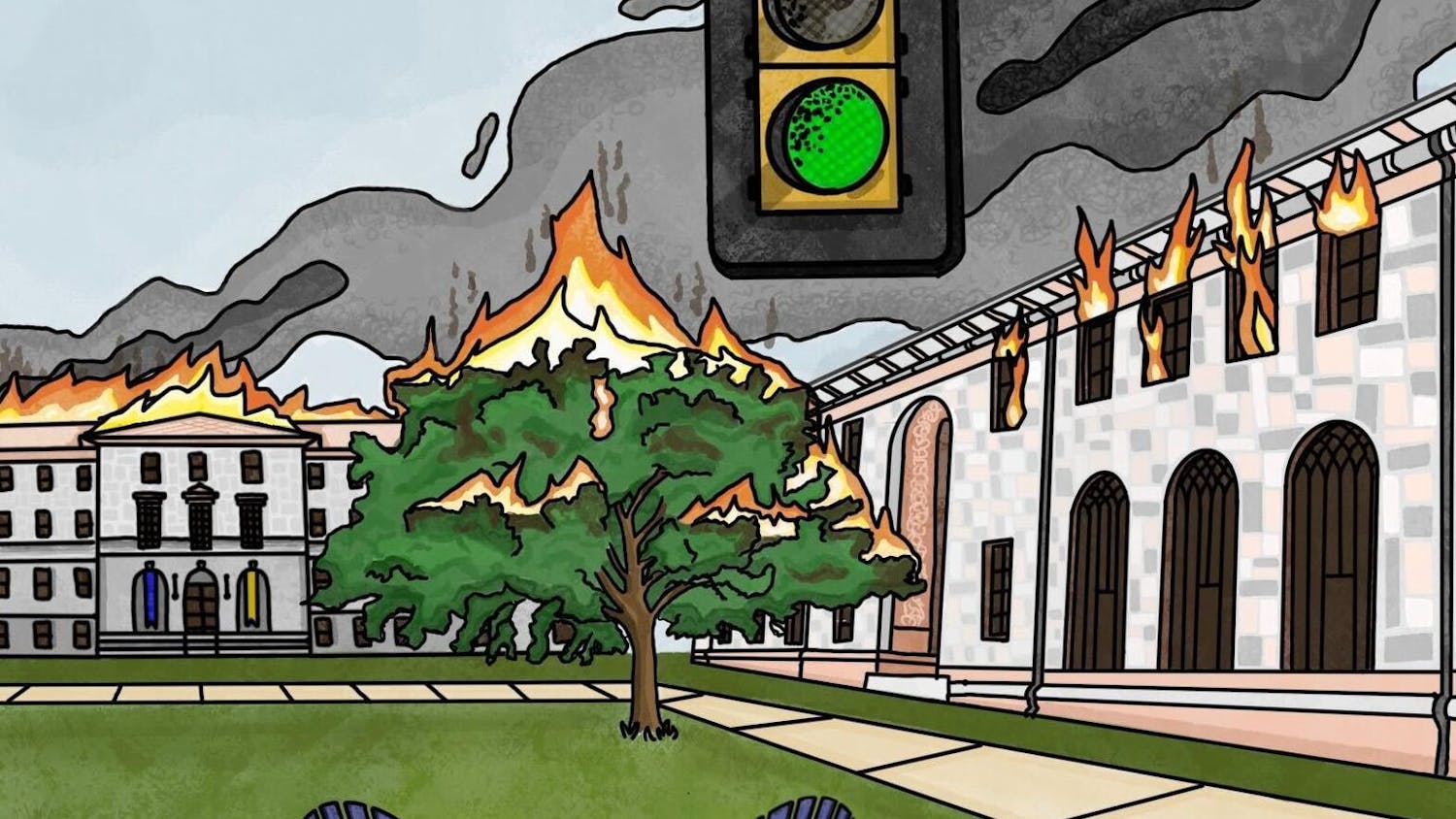Curving and spiraling around the room, the 100-foot-long performance art piece holds a powerful presence in the Carlos Museum's "And I Must Scream" exhibition.
As you begin to walk through the gallery, the works themed around global crises urge you to introspect. Suddenly, you are enveloped in a vision of saffron.On one end of the massive tube, which doubles as a costume, artist Anida Yoeu Ali is seated with just her head visible through the fabric.
Ali performed “The Buddhist Bug” at the museum March 20 over the course of an hour and a half. Her Bug persona is a displaced, insect-like creature that aims to engage and connect with different communities and environments. The artwork combines installation, photography and video to spark conversations about religious identity and belonging.
Ali, whose work explores themes like otherness and identity, has performed “The Buddhist Bug” across the world and has received grants from the National Endowment for the Arts and the Rockefeller Foundation. The costume is inspired by her experience as a refugee, with the saffron color symbolizing Buddhism and the hijab representing Islam. Together, these symbols visually depict her struggle to synthesize her upbringing as a Khmer Muslim woman with her interest in Buddhism.

Ali’s performance is not a choreographed presentation but instead develops organically through interactions with viewers. Some sit or kneel in front of her in silence, returning her calm gaze or offering words of gratitude and reflection. Others mirror her movements as she sways gently and tilts her head. A few make offerings through their art; one audience member plays the ocarina while Ali moves to its rhythm.
In some cases, touch guides the interaction. A woman strokes Ali’s head then gently runs her fingers around her face. In response, Ali rests her cheek against her palm.
The exchanges are reciprocal: a two-way transmission of appreciation. A little boy, shy at first, grows gradually more comfortable with engaging with her as he approaches her in intervals. A group of visitors ask for a picture with her and she rests her head on one of their shoulders, posing playfully. Ali matches the actions and energy of these interactions, keeping with her persona’s ability to change shape to fit different environments.
Ali’s performance brings the audience together; the room buzzes with light conversation. When I meet Ali, I instantly feel peaceful. I tell her this, and she smiles.
Leaning forward, she gently nods a welcome as I sit in front of her. We observe each other, and she follows my gaze as I look at the waves of fabric around us. She looks at me knowingly, and I feel a wave of inexplicable joy.
While Ali kneels in the main room, another performer lays in the adjoining room, hidden in the saffron except for the feet peeking out, inviting viewers to interact with them. While the great distance between Ali’s face and the feet is slightly disconcerting at first, I am drawn to the absurdity and creativity behind the work. Hearing footsteps, the toes wiggle out a friendly hello. They flex outward, inviting viewers to come closer. Some bend down and tickle the feet, while others press their own feet against them. The scene is childlike in its innocence.
Although “The Buddhist Bug” symbolizes Ali’s experience with conflict, it also represents freedom, with both the performer and the audience presenting their natural reactions. On her website, Ali writes, “I believe performing narratives is an act of social engagement that contributes to collective healing.”
A video artwork behind the installation plays a scene in a bustling marketplace where Ali, as the Bug, watches calmly over the shoulders of shopkeepers as they sort through fish. It is surreal but somehow did not seem out of place.
Photographs, the third medium used in the artwork, line the walls. They depict Ali in different locations, such as an outdoor marketplace or a classroom. In the images, the installation takes the shape of the space it occupies.
The work weaves in humor while also capturing the weight of the topic. “The Buddhist Bug” is a constant presence, watchful in the background, just like in the performance photography. It serves as a reminder that struggles with identity and displacement are continuous. The length of the performance creates a comfortable space where visitors can come and go as they choose. Because you are constantly in and out of the space, you are made part of the work’s journey rather than just a mere observer— the progression of emotions apparent, as they expand from the initial awe and intrigue, to more reflective joy or even pain.
The performance invites viewers to be childlike and curious. This urges self-transformation, however minor. For me, this meant learning to converse and connect without words.
About halfway through the performance, a woman approached Ali, kneeled and began to dance. Her movement was free-flowing as she tilted her head backward and outstretched her hands. She leaned in close to Ali, and they rested their heads against each other. Moved by the performance, I approached the audience member afterward and discovered her to be Cristal Sabbagh, a visual and multidisciplinary performance artist and an educator who attended undergraduate school with Ali.
“I remember the inception — where it started and where it’s gone — all the iterations and different spaces,” Sabbagh said. “Having this type of interactive exchange with her, and to exchange emotion and spirit, was beautiful and stunning.”
The artwork plaque described “The Buddhist Bug” as an “invasion of personal space.” This statement holds true. You become one with the Bug, the viewers and the space, if only for a few moments. If you allow yourself to fill up with questions, you’ll find that you’re prodded to look inward for the answers.







